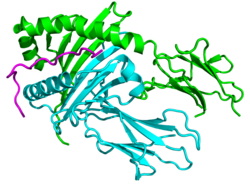Disease association
Autism
A four-loci genotype study showed that A*01-B*07-DRB1*0701- DQB1*0602 (P = 0.001, OR 41.9) and the A*31-B*51-DRB1*0103- DQB1*0302 (P = 0.012, OR 4.8) are positively associated with autism among Saudi patients.
Diabetes
Several alleles of HLA-DQB1 are associated with an increased risk of developing type 1 diabetes. [7] [8] [9] The locus also has the genetic name IDDM1 as it is the highest genetic risk for type 1 diabetes. Again the DQB1*0201 and DQB1*0302 alleles, particularly the phenotype DQB1*0201/*0302 has a high risk of late onset type 1 diabetes. The risk is partially shared with the HLA-DR locus (DR3 and DR4 serotypes).
Celiac disease
Celiac1 is a genetic name for DQB1, the HLA DQB1*0201, *0202, and *0302 encode genes that mediate the autoimmune coeliac disease. Homozygotes of DQB1*0201 have a higher risk of developing the celiac disease, relative to any other genetic locus. [10]
Narcolepsy
Other HLA-DQB1 alleles are associated with a predisposition to narcolepsy, [13] specifically HLA-DQB1*0602, which is carried by over 90% of patients with narcolepsy-cataplexy. [14]
This page is based on this
Wikipedia article Text is available under the
CC BY-SA 4.0 license; additional terms may apply.
Images, videos and audio are available under their respective licenses.







